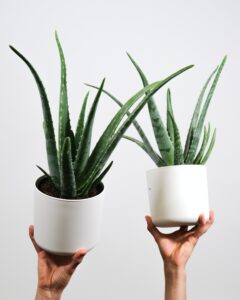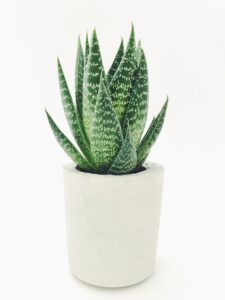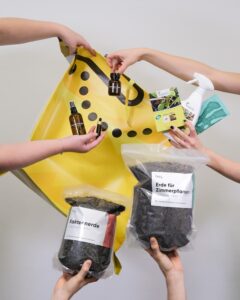Aloe vera, also known by its scientific name as aloe barbadensis, is a popular houseplant with multiple growth requirements. The plan is commonly used for treatments in skin treatments such as sunburn, irritations, and scar healing. While aloe vera has been touted to treat scar conditions such as raised scars and keloids, it does not appear to have any effect in reducing scar symptoms.
Nonetheless, aloe vera’s medicinal properties are known all across the world. A favorite of both ancient and modern civilizations alike, aloe vera was widely used by the Egyptians and Chinese; and, now, they’re widely used in modern medicinal products.
Most aloe vera products you may find won’t come in the raw plant form. Rather, they’ll be processed into separate products. They are most commonly seen in gel form.
However, that doesn’t mean the plant in its raw form isn’t worth growing. In fact, many products that claim to contain aloe vera in them actually don’t have the plant as its primary ingredient. If you’re purchasing a gel or other aloe vera product, make sure to read the labels and ingredients list. If it doesn’t say aloe barbadensis in the first part of the ingredient list, it’s likely a combination of other irrelevant ingredients.
So, there’s great value in growing your own aloe vera. If you’re looking for skin treatments that you can access immediately without having to use fake or processed aloe products, growing is your best option.
However, growing the plant comes with some considerations; there are a lot of aloe vera growth requirements one should consider if one wants to have a healthy batch of plants readily accessible.
Providing proper care for your aloe vera plant can seem daunting; but, it becomes considerably simpler when you understand specific plant needs.
In this article, we’ll delve into aloe vera growth requirements and how to take care of it –such that it remains all year round!
We will begin with an overview of the ideal light, temperature, and humidity conditions that facilitate a thriving and healthy aloe vera. This will include notable health indicators, watering practices, potting rules, and timing rituals for your aloe vera plant.
Table of Contents
- Understanding Aloe Vera Growth Requirements
- Creating the Perfect Conditions for Aloe Vera Plants to Flourish
- Sunlight
- Well-Drained Soil
- The Goldilocks Watering Technique:
- The Sweet Spot for Temperature Range:
- Room to Grow
- Choosing the Right Pot
- Feeding
Understanding Aloe Vera Growth Requirements
Aloe vera is a succulent plant renowned for its versatile medicinal and cosmetic properties. Though it thrives in a variety of climates, cultivating this plant involves the understanding of its specific growth requirements. Aloe vera belongs to the Asphodelaceae family and is native to regions of Africa but has adapted well to environments worldwide. Key factors that influence the growth of aloe vera include sunlight, proper soil, adequate watering, temperature ranges, growth environment, and feeding.
Creating the Perfect Conditions for Aloe Vera Plants to Flourish
Among the pantheon of home-grown plants, Aloe Vera stands tall as a perennial favorite.
Not only does it add a touch of green to the surroundings, it’s full of healing properties that can soothe burns and scrapes, a natural first-aid kit right at home.
To unravel the mystery of what makes Aloe Vera flourish, let’s explore the conditions that an Aloe Vera plant needs to thrive.
Plenty of Sunlight
Just like your pet, Aloe Vera adores basking in bright but indirect light. Being native to the hot climate of the Arabian Peninsula, it shouldn’t surprise anyone to learn that Aloe Vera plants thrive when getting at least six hours of light per day. If your plant is indoors, placing it near South or West-facing windows is usually a good bet.
However, ensure there is no harsh direct sunlight! Place your plant in an area where the sun passes through a transparent or somewhat fabric-meshed surface such as window curtains, blonds, or even just to the side of a window. By receiving indirect sunlight, you’ll prevent your aloe vera plant from getting damaged by too much direct sunlight exposure –which can lead to leaves that dry out faster than normal.
Also, consider changing up where you place your aloe plant –and all plants for that matter– depending on the seasons.
Well-Drained Soil
Using the right soil is an integral step in aloe vera care, or any plant care for this matter.
It’s half the battle won!
The Aloe Vera plant perfectly emulates the “less is more” philosophy when it comes to watering. It prefers well-drained, sandy soil to prevent water from sitting at its roots. You can easily create this perfect soil type by mixing cactus potting soil, or a regular potting soil mixed with perlite or building sand.
The Goldilocks Watering Technique
A common myth of aloe vera is that you don’t need to water it because it’s a desert plant.
While it’s true that Aloe Vera loves desert-like conditions and can tolerate dry periods, Aloe Vera appreciates being watered deeply.
But remember, not too much, not too infrequent—just right. To learn more details about watering aloe vera, check out this article!
The Sweet Spot for Temperature Range
Aloe Vera is not a fan of extreme temperatures. It does best in temperatures between 55°F and 80°F. In the colder months, it is advised to bring Aloe Vera indoors if outdoor temperatures drop below 50°F.
Room to Grow
Repotting the Aloe Vera as it grows is a must for robust health.
Being a succulent, it tends to grow offshoots around the base. Make sure to provide the main plant enough room to grow, by separating babies into new pots. Regular re-potting also minimizes the chances of root rot.
Choosing the Right Pot
Picking a pot for your Aloe Vera plant isn’t just about aesthetics.
Certain pots can neglect the unique needs of our prickly friend in favor of trendy looks or cheap prices. Succulent enthusiasts will find a treasure of options from terra-cotta to plastic pots.
But here’s a tip for taking care of your aloe vera the right way: terra-cotta pots are the real deal.
With porous walls, they provide unmatched aeration and promote evaporation of excess water; This is especially crucial, considering Aloe Veras are sensitive to overwatering. Avoid anything overly large and opt for a pot that aligns closely with the size of your plant.
And don’t forget about drainage holes – they’re a must to prevent root rot.
Feeding
Your Aloe Vera plants will thank you for a yearly feed. Give them a balanced, water-soluble fertilizer diluted to half strength during springtime, which is their primary growth period.
There you have it! Six simple steps to provide the ideal conditions for your Aloe Vera plants to not only survive but flourish. Remember that the key to plant care is patience and observation. By learning and understanding the unique needs of this humble plant, you’ll soon be on your way to hosting a beautiful sun-kissed Aloe Vera at your home. And, don’t forget: your sweet aloe vera plant can be used to treat minor injuries or even create your own home remedies. If you fancy yourself a DIY-er having aloe vera around can make a big difference in your day-to-day life!
If you enjoy our guides, consider following our blog! Or, if you have any questions about plant care, the world of botany, or even just anything STEM-related, consider contacting us through our contact page!















